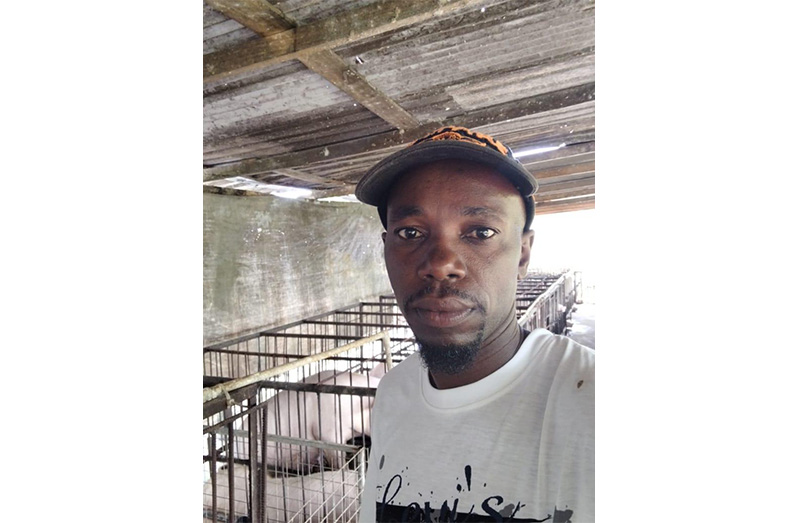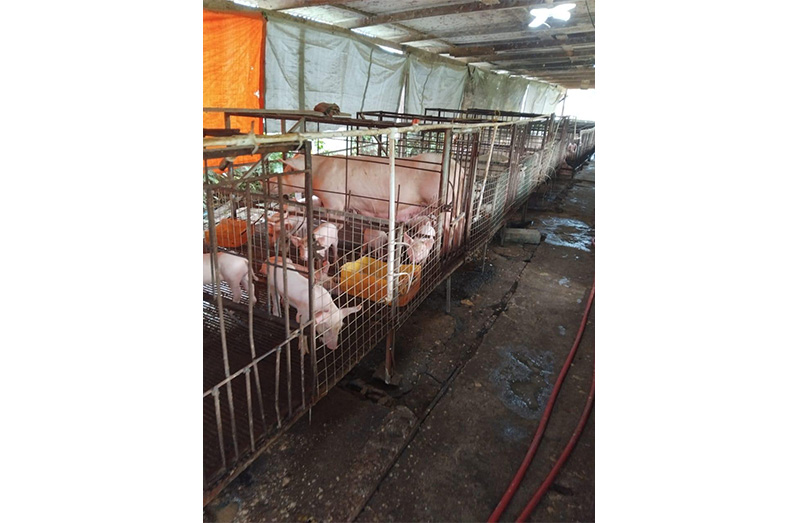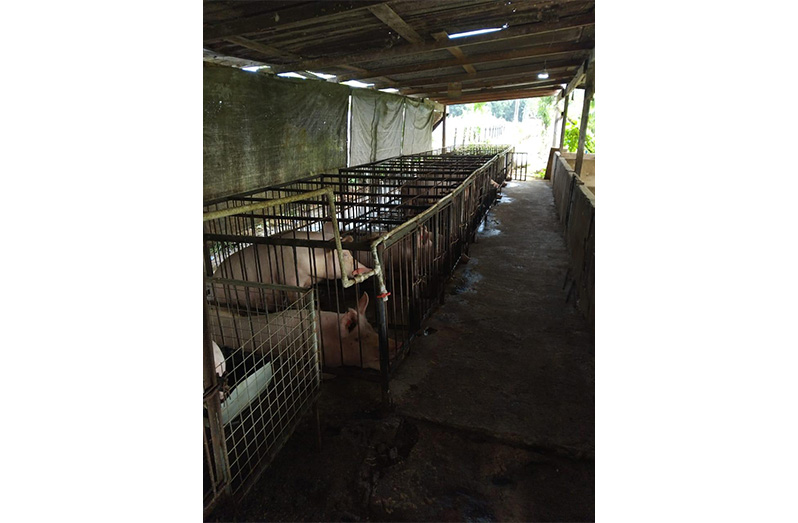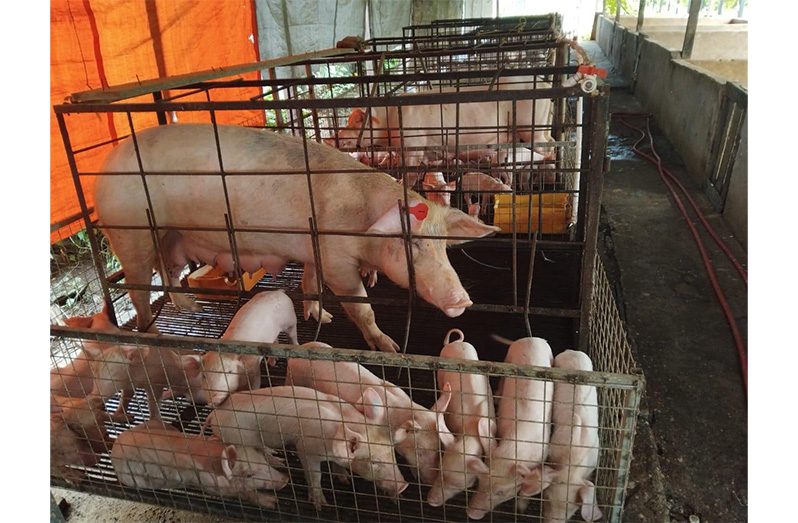THROUGH his direct intervention of creativity and determination, Delroy Barron, a swine farmer, has made significant strides in expanding his farm.
With his unconventional way, he self-invented some strategies that are new to Guyana, creating a model farm in an effort to extend and preserve the life of his pigs.
He has invented his own version of the ‘farrow crate’ for both mother and piglets, and also created a gestational section for the comfort of his pigs.
Barron also utilises artificial insemination (AI) at his farm, which has been successful and has caused his swine population to multiply within a short space of time.
All this has been made possible with the construction of an all-weather road in his community, which provides him with direct access to his farm from the main road. He can now take feed in large quantities there, allowing him to expand even further.
Barron was overjoyed with the new development in his village — a concrete strip that allows him to drive directly to his farm from the main road — which was previously a mud dam, inaccessible before the construction of the new road.

He is very thankful to the current administration for fulfilling their promise during a community meeting in the village.
The new road was built about four months ago. Even though it took time, it happened, and he is simply overjoyed because it is easier for them now to get to the farm.
Barron is a resident of Korthaadt, West Bank Berbice, and is one of the largest swine farmers in the community.
The 39-year-old told Pepperpot Magazine that he grew up in swine farming, as his father had been involved in it before his birth. When he came of age, it was handed over to him, so he took it on boldly until he migrated.
He was forced to sell the pigs and went abroad to work; however, he returned to Guyana five years ago from Barbados with his wife and daughter and had to make a living.

He automatically went back into swine farming on a small scale. He had to start from the ground up once again. However, he worked as a taxi driver to earn a living, and after accumulating some money, he invested it in buying pigs to expand his farm.
Barron said he worked as a taxi driver from Berbice to Georgetown, as he was determined to earn a living from being self-employed, rather than as a swine farmer.
Since 2010, he has been developing his farm in stages to create a model unlike any other and has invented new additions. He currently has 200 pigs after securing a loan to reach the standard he is today.
Barron reported that he worked towards making his pig farm reach an acceptable standard, as schools would visit and learners would get a firsthand view of what pig farming is about.

He wanted to raise the standards of his farm, and he was motivated to do so despite the challenges and struggles. He is now at a stage where he is expanding — under construction — but needs help in getting it done, as he has exhausted his savings on other upgrades on the farm.
Barron reported that the Ministry of Agriculture (MOA), in the form of the Guyana Livestock Development Authority (GLDA), has been assisting incrementally. After he developed his swine farm to an acceptable standard, he met the requirements and was permitted to participate in the AI programme.
It was his first time participating in the AI programme introduced by GLDA this year, which utilised three pigs and resulted in rapid multiplication within a short period.
From three pigs, he got 36 piglets, which allowed for a quick turnover to profitability. He is pleased at the prospect of earning more, as he is also a pork butcher who sells at Canje three days a week, and often there is a demand for pork.
As such, he is required to provide 600 pounds of pork to the market weekly, and without the advent of AI by GLDA, he would not have been able to do it.
Barron explained that his piglets were dying on a large scale; he was losing a lot, and one day he pondered why. So, he decided to create a parallel farrowing crate from scratch to house both the mother and piglets to see the results.
He told Pepperpot Magazine that he turned to YouTube because he had no prior knowledge of fabrication or welding, and he was self-taught through online tutorials.
Barron invested in buying a welding plant and a generator, which cost him $400,000 out of pocket. He then made two farrowing crates and saw good results; the mortality rate of his piglets went down significantly.
Today, Barron’s swine farm is equipped with five farrow crates. Additionally, he has developed a six-foot, 22-inch gestational section to house his pregnant pigs, which helps stabilise them, and the results are equally good.
The swine farmer added that this type of farming is a costly venture and he would have to travel from his village to Corentyne to buy feed for his pigs in bulk, at a cost of $7,000 per bag, since he uses about 13 bags per week.
Barron explained that with proper and timely nutrition, the pigs grow as they should. Because it is a significant investment for him, he has to put measures in place to oversee the farm and ensure its smooth operation.
As a solo farmer, he gets the work done, which is time-consuming, but he loves what he does for a living and doesn’t mind the time spent rearing pigs.
Barron told the Pepperpot Magazine that he is in the process of weaning about 45 piglets because they have reached six weeks, four days’ growth, and as a pig breeder, this process occurs in stages.
As a solo swine farmer on a large scale, he occasionally receives support from a friend who also resides in the village, but emotional support always comes from his family.
Barron reported that he is grateful for the support of GLDA, which sends staff to lend support from time to time in various forms. He would like their continued assistance to ensure his farm remains up to standard.
“This is my daily bread, this farm, so I have put my everything into it. I am in the process of expanding — a section is under construction — I would like to rear more pigs, but it would cost in excess of $2M, and this is where I need the help to make it happen,” he said.
Barron noted that due to his commitment to his farm he is unable to do many things, including coming to the city for more than two years, but he doesn’t mind at all.
He has to feed the pigs at specified times during the day, and if it doesn’t happen at the scheduled times, he will stay until dark.



.jpg)










